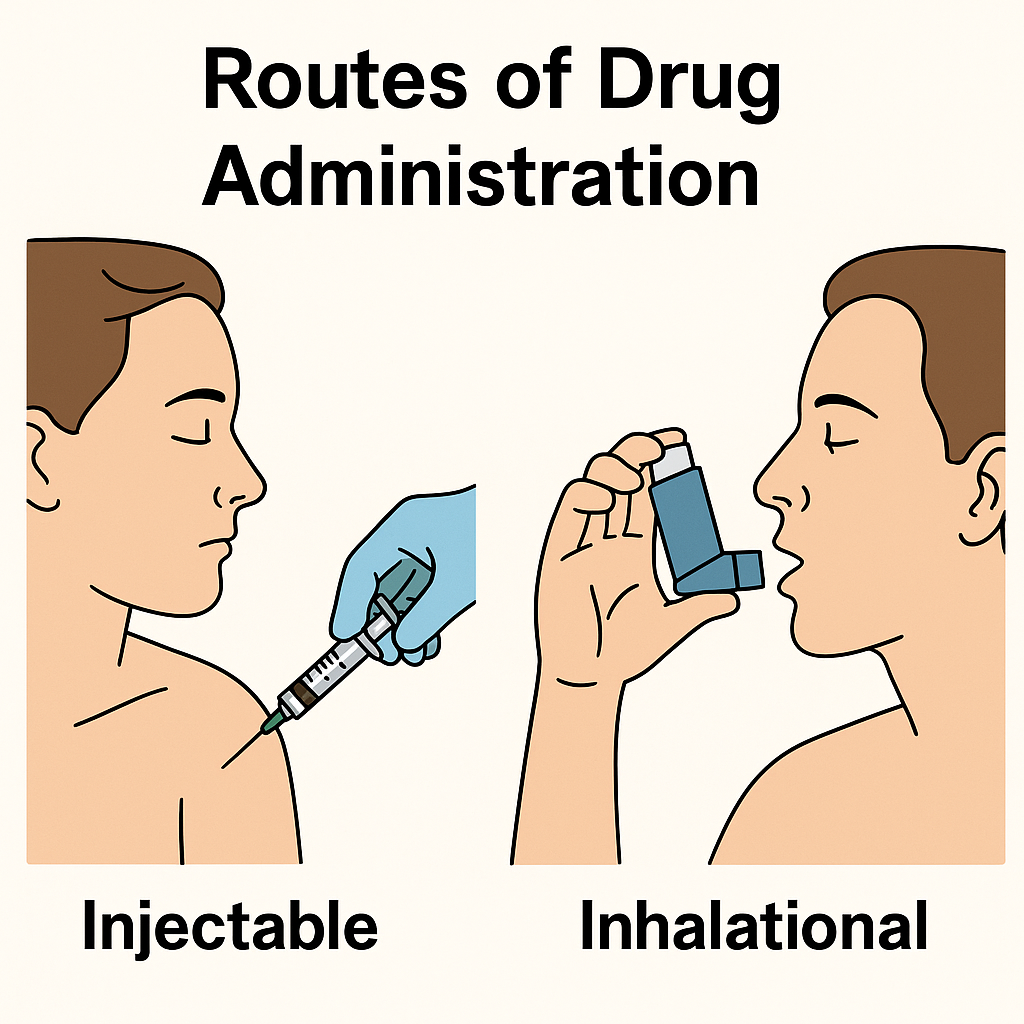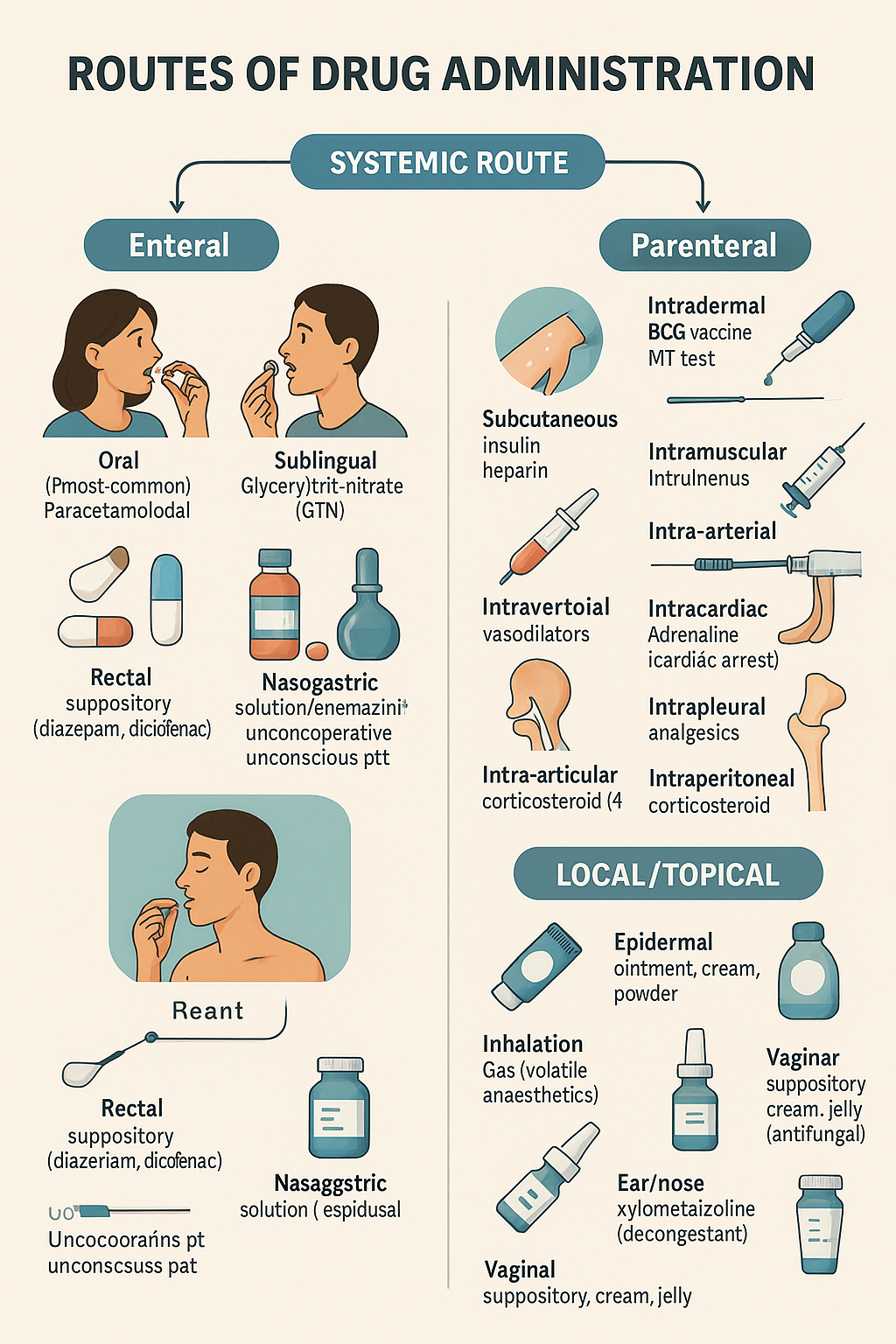ROUTES OF DRUG ADMINISTRATION

ROUTES OF DRUG ADMINISTRATION
A) SYSTEMIC ROUTE
1) Enteral:
- Oral (most common): Paracetamol, metronidazole
- Sublingual: Glyceryltrinitrate (GTN)
- Buccal: Antacid, vit.C
- Rectal: suppository (diazepam, diclofenac), solution (enema simplex)
- Nasogastric: solution/suspension in uncooperative, unconscious pt
2) Parenteral:
- Intradermal: BCG vaccine, MT test
- Subcutaneous: insulin, heparin
- Intramuscular: pethidine, diazepam
- Intravenous: insulin, heparin
- Intra-arterial: vasodilators
- Intrathecal & epidural: local anaesthetics
- Intracardiac: adrenaline (cardiac arrest)
- Intrapleural: analgesics
- Intra-articular: corticosteroid (RA)
- Intraperitoneal: corticosteroid
B) LOCAL/TOPICAL:
- Epidermal: ointment, cream, powder (antifungal)
- Transdermal:
- Absorption of drug through skin (systemic action)
- GTN patch (angina pectoris)
- Inhalation: gas (volatile anaesthetics), aerosol (bronchodilator)
- Conjunctival: chloramphenicol eyedrop
- Ear/nose: xylometazoline (decongestant)
- Vaginal: suppository, cream, jelly (antifungal)
Advantages of oral route:
- safe, cheap & easy to administer (most common)
- self medication possible
- no need of sterilization
- no fear of pain
Limitations of oral route: *
- irritant & foul smelling drugs can’t be given
- slow onset of action_ delayed absorption
(not in emergency condition)
- not for unconscious & uncooperative pt
- Can’t be given during vomiting
- Drugs destroyed by gastric juice can’t be given.e.g: insulin, heparin
- Drugs having hepatic first pass metabolism not given orally. eg: GTN, morphine
Advantages of sublingual route:
- self medication possible
- rapid onset of action (emergency condition)*
- avoid first pass metabolism (bioavailability ↑)*
- not destroyed by gastric juice
- drug can be discarded once desired effect obtained so less chance of toxicity
Disadvantages of sublingual route:
- irritant & foul smelling drugs can’t be given
- large doses can’t be given
- not for unconscious pt
Advantages of inhalational route:
- rapid onset of action (emergency condition)
- drug delivered directly to site of action
- avoid first pass metabolism & systemic toxicity
Disadvantages of inhalational route:
- costly
- special apparatus & technique required
- irritant drugs can’t be given
- prolonged inhalation _oropharyngeal candiasis
Advantages of rectal route:
- suitable for infants & old age, unconscious pt
- avoid gastric irritation
- suitable in case of vomiting
- avoid first pass metabolism
Disadvantages of rectal route:
- pt embarrassed
- absorption slow & incomplete
- rectal inflammation possible
- not suitable in diarrhoea
- stool reduces extent of absorption
Advantages of intravenous route:*
- rapid onset of action (emergency condition)
- irritant, foul smelling & unpleasant drugs can be given
- large volume & water soluble drugs can be given
- for unconscious & uncooperative pt
- Suitable in vomiting & diarrhoea
- 100% bioavailability
- avoid first pass metabolism
Disadvantages of intravenous route:
- self administration not possible
- requires strict aseptic measure
- extravasations leads to local inflammation & necrosis
- expensive

Advantages of subcutaneous route:
- self medication possible*
- Painless*
- irritant & foul smelling drugs can be given
- slow & sustained action, prolonged duration of action
- significant bioavailability (75-100%)
- avoid first pass metabolism
Disadvantages of subcutaneous route:
- slow absorption
- repeated injection can cause lipodystrophy
- large volume cannot be given
Advantages of intramuscular route:
- rapid onset of action
- uniform absorption_ prolonged action
- significant bioavailability
- Irritant drugs & large volume can be given
Disadvantages of intramuscular route:
- pain at injection sites
- self administration not possible
- local tissue necrosis & hematoma formation
How routes of administration modify drug action/ What factors modify selection of drug routes/ Criteria for selection of route of administration of drug
A) Physiochemical property:
1) Formulation of drug:
- Solid : oral, rectal, sublingual
- Liquid : enteral, parenteral
- Gaseous: inhalation
2) Solubility of drug:
- Water-soluble: i/v
- Lipid-soluble_ oral, rectal
3) Ionization of drug
4) pH of drug: Acidic and Basic
5) Bioavailability: High (i/v) & Low (oral)
6) Gastric juice
7) Bypass hepatic first pass metabolism:
Morphine (i/v), GTN
B) Site of action:
- Approachable & localized_ eye drop
- Non-approachable & generalized_ antihypertensives
C) Pt. condition:
- Unconscious _ parenteral
- Conscious_ any route
- Severe vomiting/diarhoea
D) Pt age:
- Infant/old_ rectal
E) Severity of disease/ onset of action:
- Acute bronchial asthma (rapid action)_ salbutamol inhaler
- Chronic (delayed action)_ salbutamol tablet
F) Desired duration of action:
- Slow_ s/c or im
- Prolonged_ transdermal or s/c
G) Adverse effect:
- Less _salbutamol inhalation
- More_ salbutamol tablet
For additional information on pharmaceutical standards and safe drug delivery practices, refer to the World Health Organization’s official guidelines on routes of administration. This resource outlines global safety protocols and route classifications in detail.


